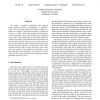Free Online Productivity Tools
i2Speak
i2Symbol
i2OCR
iTex2Img
iWeb2Print
iWeb2Shot
i2Type
iPdf2Split
iPdf2Merge
i2Bopomofo
i2Arabic
i2Style
i2Image
i2PDF
iLatex2Rtf
Sci2ools
SP
2003
IEEE
2003
IEEE
Specifying and Verifying Hardware for Tamper-Resistant Software
We specify a hardware architecture that supports tamper-resistant software by identifying an “idealized” hich gives the abstracted actions available to a single user program. This idealized model is compared to a concrete “actual” model that includes actions of an adversarial operating system. The architecture is verified by using a finite-state enumeration tool (a model checker) to compare executions of the idealized and actual models. In this approach, software tampering occurs if the system can enter a state where one model is inconsistent with the other. In performing the verification, we detected an replay attack scenario and were able to verify the security of our solution to the problem. Our methods were also able to verify that all actions in the architecture are required, as well as come up with a set of constraints on the operating system to guarantee liveness for users.
| Added | 05 Jul 2010 |
| Updated | 05 Jul 2010 |
| Type | Conference |
| Year | 2003 |
| Where | SP |
| Authors | David Lie, John C. Mitchell, Chandramohan A. Thekkath, Mark Horowitz |
Comments (0)

